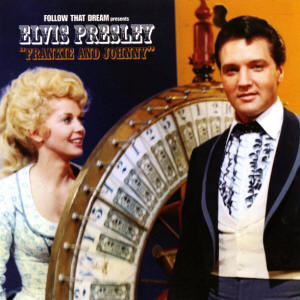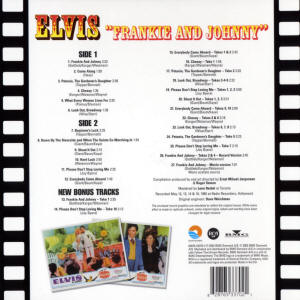Verdict
As usual the classic album sounds good, is well packaged and includes several interesting outtakes.
![]()
(C) Sony Music Entertainment / Follow That Dream Records,
The ultimate site about the king of the analogue age


When Follow That Dream Records started their series of classic albums in 2003 "Frankie And Johnny" was amongst the first releases. The soundtrack was presented on a single cd, housed in a 5" digi-pak and accompanied by an informative and well designed booklet. As you can see above the booklet cover shows the original version of the photo, which RCA Victor changed for the album sleeve. Back in 1966 the art department of the label cut Donna Douglas out and put another head on Elvis' body. Colonel Parker thought his client looked a little puffy in the face and therefore used an older version.
Because the producers (Ernst Jorgensen and Roger Semon) insisted on using the original mix, the well known recordings were simply remastered. However, the outtakes needed to be mixed before release and therefore sound a lot better than the masters. Elvis' voice was not brought to the fore so much and everything sounds more vital and brighter. Since 2003 the master recordings have been remastered several times and now sound a tad better than the version on this set. But at the time the FTD release was the best sounding source. Unfortunately Follow That Dream Records refuses to keep up with the times and sticks to the extincted cd-format.
In this review I just deal with the tracks not featured on the original release. For a review of RCA Victor's "Frankie And Johnny" just tap HERE.
Frankie And Johnny (take 1)
The recording starts with the anouncement of the sound engineer and some practices by the pianist. The first walkthrough is hampered by Elvis stumbling upon the lyrics / the melody and harmony vocalists who don't harmonize all that well. At the end of the song the king is too far from the microphone. To make it short: There's a lot of work to be done.
Please Don't Stop Loving Me (take 10)Elvis recorded 19 takes, so we are more or less in the middle of the session. By now everyone knows what to do, there are just a few details to iron out.
Everybody Come Aboard (takes 1 & 2)The producer announces "On With The Show" and the take is started. Unfortunately Elvis gets muddled after a few lines, so the attempt is stoped. The harmony singers make fun of the situation and sing a sad "oooooohhhh". The second take is a complete performance, but the king has obvious problems to emphasize the words. At the end the band keeps going and improvises some great dixiland music.
Chesay (take 1)Somewhat out of reach of the microphone the part of the gypsy is sung, then Elvis takes over. The simple clap along tune is no challenge for him.
Petunia, The Gardener's Daughter (take 2)The track is announced and the recording starts. Neither Elvis, nor Eileen Wilson (who sings the part of the actress Donna Dougles) have any problems with the song, but nevertheless the performance falls apart at the end.
Look Out, Broadway (takes 3-5)After a few words Elvis has to laugh, so take 3 is finished very fast. The next attempt doesn't get much older, this time because someone in the studio is talking. Take 5 finally is a complete performance, but it's not as dashing as the master.
Petunia, The Gardener's Daughter (take 5)The sound engineer says "take three" at which Elvis jokingly askes "OK, what are we taking?". The engineer corrects himself, announces "take 5" and explains that the complete performance has to be repeated. Almost everything works well, but at one point Elvis sings a tad too timid.
Please Don't Stop Loving Me (take 7)By now everybody knows his part, there are just a few minor glitches that have to be ironed out. In contrast to the master Elvis sings the finale a bit higher.
Frankie And Johnny (takes 3 & 4)At the beginning of the second verse Elvis looses his step and stops the take by saying "I'm sorry".
Frankie And Johnny (movie version)The album closes with the seven minutes long movie version. Because the stereo tape is missing in the vaults, Ernst Jorgensen and his team had to use a vinyl acetate in monaural sound.
As usual the classic album sounds good, is well packaged and includes several interesting outtakes.
![]()
(C) Sony Music Entertainment / Follow That Dream Records,